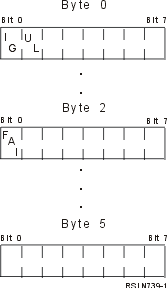While troubleshooting, you might need to view the information of the destination-address and source-address frames.
These are the formats of the frames:
Destination address format:
This figure shows the destination address format:
Some of the bits indicate the characteristics of the destination address:
- I/G bit (bit 0 of byte 0) indicates the type (individual or group)
of the destination address. These are the possible values for this bit:
- 0: The destination address is an individual address (an address that is associated with a device on the network).
- 1: The destination address is a group address (a multiple destination address that is associated with one or more devices on the network).
- U/L bit (bit 1 of byte 0) indicates who defined the address. These
are the possible values for this bit:
- 0: The manufacture defined the address (it is a universally administered address or in other words a burned-in address).
- 1: The administrator defined the address (it is a locally administered address).
- Functional address indicator (FAI) bit (bit 0 of byte 2) indicates
the address type of the locally administered address. These are the possible
values for this bit:
- 0: The address is a functional address.
- 1: The address is a group address.
Source address format:
A source address is always an individual address (that is, an address that is associated with a device on the network). This figure shows the format of the address:
Some of the bits indicate the type of address that the source address contains:
- Bit 0 of byte 0 indicates whether or not the frame contains a routing
information field. These are the possible values for this bit:
- 0: The routing information field is present.
- 1: The routing information field is not present.
- Bit 1 of byte 0 indicates the type of the address. These are the
possible values for this bit:
- 0: The address is a universally administered address. Because this bit is 0, the burned-in address cannot be greater than X'7FFFFFFFFFFF'.
- 1: The address is a locally administered address. Because this bit is 1, the group address must be greater than X'800000000000'.

